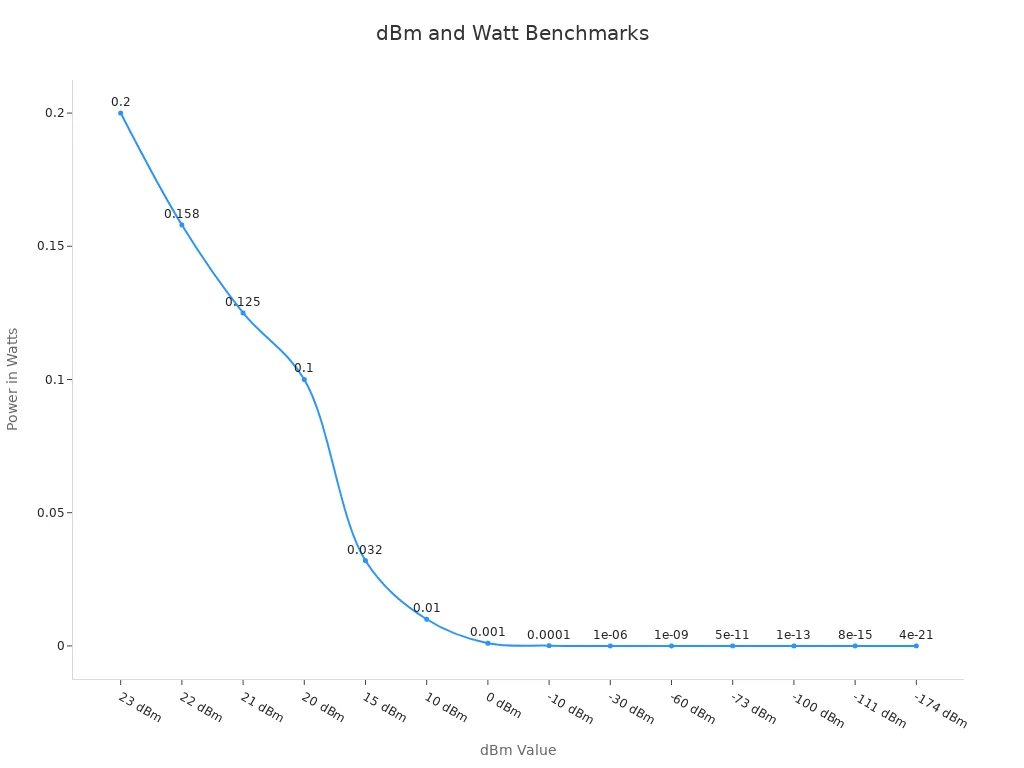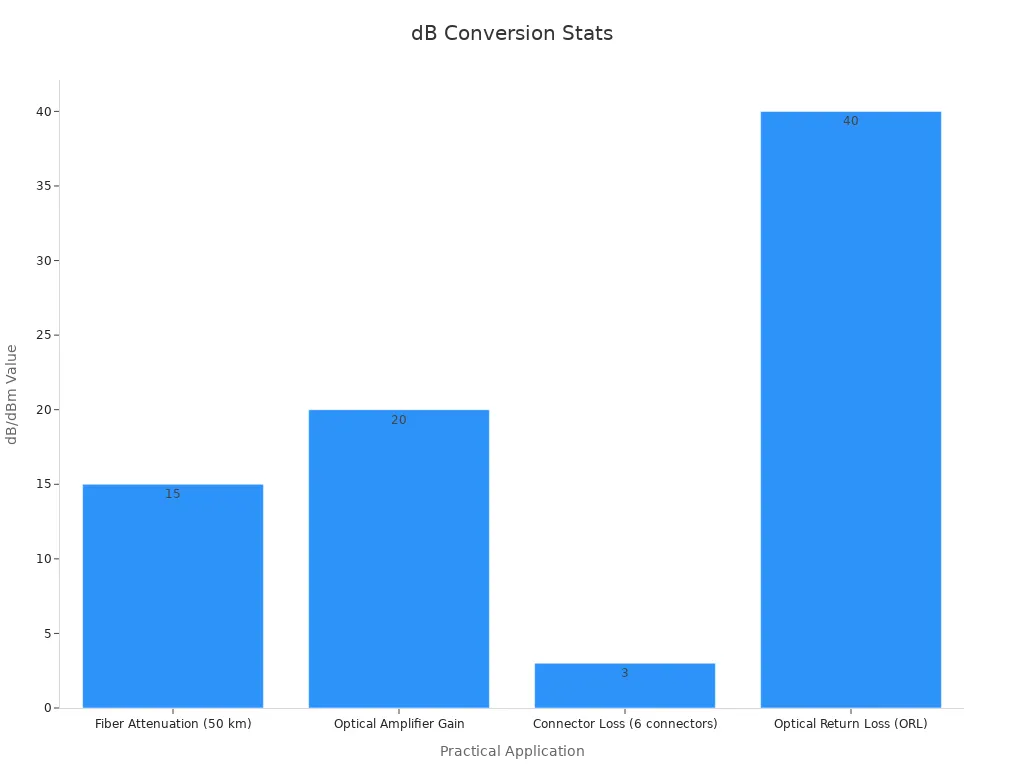![dBm to Watts Conversion]()
dBm to Watts Conversion
Formula
When you work with RF signals or wireless systems, you often see power levels written in dBm. To use these numbers in real-world calculations, you need to convert dBm to watts. The standard dBm to watts formula looks like this:
P(watts) = 10^((P(dBm) - 30) / 10)
This formula lets you turn a logarithmic dBm value into a linear watt value. You can use it for both positive and negative dBm to watts conversion. For example, if you have -10 dBm, you can plug it into the formula and get a small watt value. This is super helpful when you need to know exactly how much power your device is sending or receiving.
Tip: If you ever need to go the other way and do a watt to dBm conversion, just flip the formula:
P(dBm) = 10 * log10(P(watts)) + 30
Variables and Units
Let’s break down what each part of the formula means:
dBm: This stands for decibels relative to one milliwatt. It’s a way to express power on a logarithmic scale. Engineers use dBm because it makes it easier to compare very large or very small power levels.
Watts: This is the standard unit for measuring power. When you convert dBm to watts, you get a number that tells you exactly how much energy is flowing.
10^((P(dBm) - 30) / 10): This part of the formula does the heavy lifting. It shifts the dBm value down by 30 (to account for the 1 milliwatt reference), divides by 10 (because dB is a log scale), and then raises 10 to that power to get back to a linear scale.
You’ll see this conversion everywhere in RF and electronics. For example, when you set up a Wi-Fi access point, you might see the output listed as 23 dBm. Using the dBm to watts conversion, you can figure out the actual power in watts. This helps you plan coverage and avoid interference.
The importance of accurate dBm to watt conversion goes beyond just math. Technical papers, like "Beware Of Spectrum Analyzer Power Averaging Techniques," show that the way you measure and average power can change your results by up to 1 dB. That’s a big deal in sensitive systems. These studies use real measurements at different frequencies and power levels to prove the formula’s accuracy. They also show that the method you use for averaging can affect your final answer, so always use the right tools and techniques.
In real-world engineering, you’ll find that dBm measurements connect directly to practical watt output. For instance, a Wi-Fi access point at 23 dBm with a 6 dBi antenna gives you an effective radiated power of 29 dBm. That’s about 0.8 watts, which can cover up to 1800 feet in open space. This shows how dBm to watts conversion helps you predict system performance and make smart design choices.
Sometimes, the real world throws you a curveball. Things like cable losses, impedance mismatches, and reflections can change the actual power you measure. Engineers use sensitivity tests to check how close the real power is to the theoretical value from the dBm to watts formula. They measure things like voltage standing wave ratio (VSWR) and return loss to see how much power gets lost along the way. These tests help you fine-tune your setup and make sure your calculations match reality.
So, whether you’re working with positive or negative dBm to watts conversion, understanding the formula and its variables gives you the power to design, troubleshoot, and optimize any RF or wireless system.
Converting dBm to Watts Example
Step-by-Step
Let’s walk through converting dBm to watts together. You’ll see how simple it is once you break it down. Here’s the formula you need:
P(watts) = 10^((P(dBm) - 30) / 10)
Suppose you have a signal strength of 10 dBm. You want to know how much power that is in watts. Follow these steps:
Subtract 30 from your dBm value.
10 dBm - 30 = -20
Divide the result by 10.
-20 / 10 = -2
Raise 10 to the power of your answer.
10^(-2) = 0.01
So, 10 dBm equals 0.01 watts. That’s it! You just did a dbm to watts conversion.
You can use this same process for any value, even negative dBm. For example, if you have -30 dBm:
-30 - 30 = -60
-60 / 10 = -6
10^(-6) = 0.000001
So, -30 dBm is 0.000001 watts. This is a classic negative dbm to watts conversion, which comes up a lot in low-power electronics.
To help you see how different dBm values convert to watts, check out this table:
Example Number | Input Power (dBm) | Calculated Power (Watts) |
Example #1 | 40 | 10 |
Example #2 | -30 | 0.000001 |
Example #3 | 10 | 0.01 |
You can use this table as a quick reference when you need to do a dbm to watts conversion on the fly.
Result Interpretation
Now that you know how to do the math, let’s talk about what these results mean in real life. When you see a power level of 10 dBm, you know it’s 0.01 watts. That’s a typical value for a small wireless transmitter, like a Bluetooth device. If you see -30 dBm, you’re looking at a very weak signal—just one millionth of a watt. Engineers often deal with these tiny numbers when testing sensitive receivers or measuring signal loss.
You might wonder why converting dbm to watts matters so much. In RF and wireless work, you need to compare power levels across different devices. Sometimes, you need to check if your transmitter meets legal limits. Other times, you want to make sure your receiver can pick up weak signals. The dbm to watts conversion helps you make these decisions with confidence.
Keep in mind, real-world measurements can have small errors. In lab tests, you might see a margin of error around 1 dB. This happens because of things like sensor mismatch, calibration drift, or even temperature changes. For example, if you measure a signal at -110 dBm, the actual value could be off by about 0.5 dB. That’s why engineers use reliable tools and double-check their results.
You’ll also see negative dbm to watts conversion in action when working with low-power devices. For instance, a wireless sensor might transmit at -20 dBm. After converting, you find it’s only 0.00001 watts. This helps you understand battery life and signal range.
dBm to Watts Conversion Table
Common Values
You probably want a quick way to look up power levels without doing the math every time. That’s where a dbm to watt conversion table comes in handy. You can use this table to check the most common dBm values you’ll see in wireless, RF, and electronics work. Each value shows you the equivalent power in watts or subunits like milliwatts and microwatts. You’ll also see where these numbers pop up in real-world devices.
dBm Value | Equivalent Power | Typical Industry Benchmark or Context |
23 dBm | 200 mW | EIRP for IEEE 802.11a wireless LAN (5 GHz) |
22 dBm | 158 mW |
|
21 dBm | 125 mW | Max output from UMTS/3G mobile phone (class 4) |
20 dBm | 100 mW | EIRP for IEEE 802.11b/g Wi-Fi (2.4 GHz), Bluetooth Class 1 |
15 dBm | 32 mW | Typical wireless LAN transmission power in laptops |
10 dBm | 10 mW |
|
0 dBm | 1 mW | Bluetooth Class 3 radio, 1 m range |
-10 dBm | 100 μW | Max received signal power in 802.11 wireless networks |
-30 dBm | 1 μW |
|
-60 dBm | 1 nW | Earth receives 1 nW/m² from a +3.5 magnitude star |
-73 dBm | 50 pW | "S9" strong signal on ham radio S meter |
-100 dBm | 0.1 pW | Minimal received signal power in 802.11 wireless networks |
-111 dBm | 8 fW | Thermal noise floor for commercial GPS single-channel bandwidth |
-174 dBm | 0.004 aW | Thermal noise floor for 1 Hz bandwidth at room temperature |
Tip: You can use this dbm to watt conversion table as a cheat sheet when you’re setting up wireless gear or troubleshooting signal issues.
Quick Reference
Sometimes, you just want to see the big picture. The chart below shows how dBm values drop off quickly as you move into negative numbers. You’ll notice that even a small change in dBm can mean a big jump or drop in watts. This is why using a dbm to watts chart or table saves you time and helps you avoid mistakes.
![Line chart showing the relationship between dBm values and equivalent watt measurements across industry benchmarks]()
You’ll see these values everywhere—from Wi-Fi routers to Bluetooth radios and even in deep space signals. If you ever feel unsure, just check the table or chart above. You’ll get the answer you need in seconds.
Remember, a quick glance at the dbm to watts table can help you make smart decisions about power, range, and device performance.
About dBm
Definition
You see dBm everywhere in electronics and wireless work. dBm stands for "decibels relative to one milliwatt." It tells you how strong a signal is compared to a tiny reference power—just 1 milliwatt. This unit helps you compare power levels, even when they are very high or extremely low. You often find dBm used in audio, radio, and telecommunication systems.
Here’s a quick table to show you how dBm works in different settings:
Context | Reference Impedance | Voltage Level (RMS) | Power Reference | Numerical Benchmark |
Audio/Telephony | 600 Ω | 0.775 V | 1 mW | 0 dBm = 1 mW; 1 dBm ≈ 1.259 mW |
Radio | 50 Ω | 0.224 V | 1 mW | 0 dBm = 1 mW; 1 dBm ≈ 1.259 mW |
A 0.775 V RMS signal across a 600 Ω load gives you exactly 1 milliwatt, which is 0 dBm. If you double the voltage, you get four times the power. That’s a jump of 6 dB, or +6 dBm. This scale makes it easy to see big changes in power with just a small change in the number.
Note: Sometimes people use dBm to talk about voltage, but it really measures power. Always check your reference to avoid confusion.
Why Convert
You need to convert dBm to watts because real-world systems run on actual power, not just numbers on a scale. When you work with transmitters, receivers, or amplifiers, you want to know how much energy flows through your equipment. This helps you design safe, efficient systems and avoid damaging sensitive parts.
Engineers and technicians rely on accurate conversion for several reasons:
You must calibrate your instruments to measure milliwatts correctly. This step keeps your dBm readings true.
Environmental factors, like temperature or cable loss, can change your results. You apply correction factors to get the most accurate power conversion.
You use precise formulas and tools—like MATLAB or Python scripts—to reduce calculation errors.
You check your manual math against automated software to catch mistakes.
Even a 1 dB error can hurt your system’s performance. For example, it can lower your signal-to-noise ratio or shrink your network coverage.
You often use dBm for quick checks, but you need watts for real measurements and safety checks. That’s why you see both dBm to watts conversion and watt to dBm conversion in engineering work. When you understand both units, you can troubleshoot, optimize, and document your projects with confidence.
Converting dBm to watts is quick and practical when you use the right formula, table, or a calculator. You can see how this helps in real-world projects by checking out the table below:
Practical Application | dB/dBm Value | Power Ratio/Percentage | What It Means |
Fiber Attenuation (50 km) | 15 dB | ~3.16% | Big power loss over distance |
Optical Amplifier Gain | 20 dB | 100× | Huge signal boost |
Connector Loss (6 connectors) | 3 dB | ~50.12% | Noticeable connector losses |
Optical Return Loss (ORL) | 40 dB | 0.01% | Very low reflection |
Power Budget Calculation | 5 dBm | — | Confirms link viability |
![Bar chart showing dB/dBm values for four practical applications]()
When you understand both dBm and watts, you make better choices in your electronics work. Experts agree that this knowledge leads to stronger networks and more reliable results. For even more accuracy, follow guidelines from IEEE and ISO, and always double-check your conversion with trusted tools.
FAQ
What is the fastest way to convert dBm to watts?
You can use the formula P(watts) = 10^((P(dBm) - 30) / 10). If you want to skip the math, try an online calculator dBm to Watts Conversion Tool for instant results.
Can I convert negative dBm values to watts?
Yes! Negative dBm values just mean very low power. Plug the negative number into the formula or use a calculator. For example, -30 dBm equals 0.000001 watts (1 microwatt).
Why do engineers use dBm instead of watts?
dBm makes it easier to compare big and small power levels. You see changes in power as simple number differences. This helps you spot signal changes quickly, especially in wireless and RF work.
Do I need to consider cable loss when converting dBm to watts?
Absolutely. Cable loss reduces the actual power that reaches your device. Always check for losses in your setup. Use correction factors or measure at the device to get the most accurate watt value.













